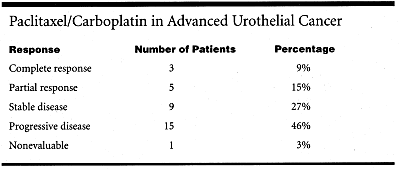Weekly Paclitaxel/Carboplatin Effective But Toxic in Advanced Urothelial Cancer
HOUSTON-Weekly administration of paclitaxel (Taxol) plus carboplatin (Paraplatin) is active in advanced urothelial cancer but probably too toxic for routine use, David M. Friedland, MD, of the Genitourinary Committee, US Oncology, Houston, reported at the ASCO meeting.
HOUSTON-Weekly administration of paclitaxel (Taxol) plus carboplatin (Paraplatin) is active in advanced urothelial cancer but probably too toxic for routine use, David M. Friedland, MD, of the Genitourinary Committee, US Oncology, Houston, reported at the ASCO meeting.
Dr. Friedland suggested that this combination “warrants further study in advanced urothelial cancer using a less intensive regimen, possibly integrated into an alternating regimen including other active agents or combinations.”
This phase II trial was based on the observations that combination chemotherapy is active against advanced urothelial cancer, that cisplatin (Platinol)-based regimens have significant toxicity, and that less toxic agents such as paclitaxel have promising activity.
To evaluate the efficacy and safety of weekly paclitaxel/carboplatin in advanced carcinoma of the urothelium, investigators enrolled 33 patients from 17 sites.
Patients had a median age of 70 years (range, 37 to 83). Thirteen patients (43%) had prior chemotherapy (5 postoperative, 5 neoadjuvant, 3 for metastatic disease), and 5 (17%) had prior radiation therapy. Data for 3 patients were unavailable.
Six-Week Cycle Then Rest
Patients were treated with paclitaxel at 135 mg/m² and carboplatin to AUC 2 by IV infusion weekly for 6 weeks, followed by 2 weeks’ rest.
The median duration of response was 12 weeks (range, 7 to 24 weeks), Dr. Friedland reported. At the time of the ASCO meeting, 16 patients were alive (48%) and 17 had died (52%).
Eight patients (24%) achieved objective response; 3 had a complete response and 5 a partial response. Nine patients (27%) had stable disease for longer than 4 weeks. Median time to progression was 3.6 months, and median survival was 5.9 months.
Response rates were 18% in patients with prior chemotherapy and 29% in patients with no prior chemotherapy. Response rates were similar in patients older and younger than 65 years.

Dr. Friedland reported that all patients who were able to tolerate a third cycle of paclitaxel/carboplatin achieved a complete or partial response, compared with only 8% of those receiving 1 to 2 cycles.
Significant Toxicity
Toxicity was significant, however. Grade 3-4 toxicities included asthenia (47%), neutropenia (37%), thromboembolism (13%), diarrhea (10%), nausea and vomiting (10%), neuropathy (7%), leukopenia (7%), and hyperglycemia (7%). Eight patients named “toxicity” as a reason for discontinuing therapy. Two patients died of sepsis.
“Objective response rates in this trial were lower than some others evaluating this combination given every 3 weeks,” Dr. Friedland stated.
He concluded that weekly paclitaxel/carboplatin shows promising activity. “However, in the current study, efficacy may have been limited by the toxicities associated with this dose-intensive regimen in an elderly, poor performance status, and frequently pretreated population. Nearly one-third of patients had stable disease at first response evaluation and may have gone on to response had they been able to tolerate further therapy. ”
The regimen warrants further study, he said, “perhaps as a 3- or 4-week regimen or at reduced doses,” Dr. Friedland concluded.